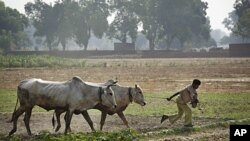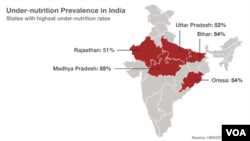NEW DELHI —
Malnutrition is more common in India than in sub-Saharan Africa, according to the United Nations. To address this "hidden hunger," Indian officials are joining forces with a U.S-based program to fortify staple foods with key nutrients.
The numbers are stark. The U.N. Children's Fund (UNICEF) says in India, one in every three children is malnourished, and nearly half of all childhood deaths are attributed to malnutrition.
The problem centers not necessarily on how much people are eating, but what they are eating. Millions in India rely on rice and wheat to fill their stomachs, but those staple foods lack crucial vitamins and minerals.
Parliament member and agriculturist M.S. Swaminathan, known as the father of India’s “Green Revolution” for introducing high-yielding crop varieties to farmers, says about 900 million men, women and children around the world are malnourished.
“Nearly two billion suffer from iron deficiency and anemia particularly women, pregnant women," he says. "Therefore, overcoming this micronutrient deficiency, or what we call hidden hunger, is of great priority to us, because enough calories alone won’t help.”
Indian leaders turned to the Washington-based non-governmental organization HarvestPlus and its use of biofortification, breeding more vitamins and minerals in staple food crops, to address micronutrient deficiency.
Last year, after a decade of research, HarvestPlus released an iron-enriched pearl millet seed to farmers in the western Indian state of Maharashtra.
The biofortified millet, which is then made into a flat bread, or roti, can provide 30 percent of the average daily iron needs of adult women, which is crucial in a region where an estimated 66 percent of children under five are anemic.
India is the latest country to enter the realm of biofortification. Several countries in Africa, including Zambia, Nigeria and the Democratic Republic of Congo, already plant seeds enriched with nutrients.
“Africans eat white sweet potato, Africans eat white maize [corn], Africans eat white cassava, but there is a big vitamin A deficiency problem," says Dr. Howarth Bouis, director of HarvestPlus. "So, we have an orange sweet potato now that has been available in Africa for the last five years and we have been disseminating that.”
In Zambia, farmers planted orange corn for the first time last November.
Bouis says yellow cassava seeds were released in Nigeria more than a year ago and farmers are harvesting the vitamin A-rich crop for the first time this year. HarvestPlus says one-third of children under five in Nigeria and 61 percent in the Democratic Republic of Congo are estimated to be vitamin A deficient.
In South Asia, HarvestPlus plans to introduce high-zinc rice in India and Bangladesh and high-zinc wheat in parts of India and Pakistan later this year.
The numbers are stark. The U.N. Children's Fund (UNICEF) says in India, one in every three children is malnourished, and nearly half of all childhood deaths are attributed to malnutrition.
The problem centers not necessarily on how much people are eating, but what they are eating. Millions in India rely on rice and wheat to fill their stomachs, but those staple foods lack crucial vitamins and minerals.
Parliament member and agriculturist M.S. Swaminathan, known as the father of India’s “Green Revolution” for introducing high-yielding crop varieties to farmers, says about 900 million men, women and children around the world are malnourished.
“Nearly two billion suffer from iron deficiency and anemia particularly women, pregnant women," he says. "Therefore, overcoming this micronutrient deficiency, or what we call hidden hunger, is of great priority to us, because enough calories alone won’t help.”
Indian leaders turned to the Washington-based non-governmental organization HarvestPlus and its use of biofortification, breeding more vitamins and minerals in staple food crops, to address micronutrient deficiency.
Last year, after a decade of research, HarvestPlus released an iron-enriched pearl millet seed to farmers in the western Indian state of Maharashtra.
The biofortified millet, which is then made into a flat bread, or roti, can provide 30 percent of the average daily iron needs of adult women, which is crucial in a region where an estimated 66 percent of children under five are anemic.
India is the latest country to enter the realm of biofortification. Several countries in Africa, including Zambia, Nigeria and the Democratic Republic of Congo, already plant seeds enriched with nutrients.
“Africans eat white sweet potato, Africans eat white maize [corn], Africans eat white cassava, but there is a big vitamin A deficiency problem," says Dr. Howarth Bouis, director of HarvestPlus. "So, we have an orange sweet potato now that has been available in Africa for the last five years and we have been disseminating that.”
In Zambia, farmers planted orange corn for the first time last November.
Bouis says yellow cassava seeds were released in Nigeria more than a year ago and farmers are harvesting the vitamin A-rich crop for the first time this year. HarvestPlus says one-third of children under five in Nigeria and 61 percent in the Democratic Republic of Congo are estimated to be vitamin A deficient.
In South Asia, HarvestPlus plans to introduce high-zinc rice in India and Bangladesh and high-zinc wheat in parts of India and Pakistan later this year.








